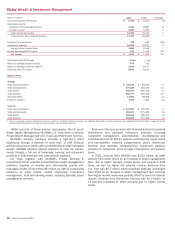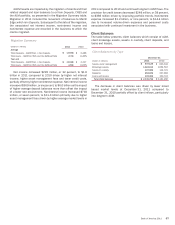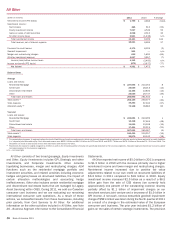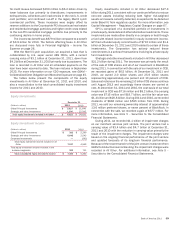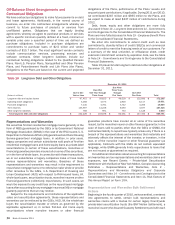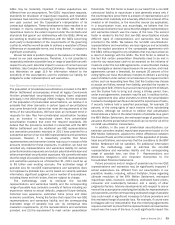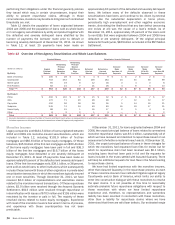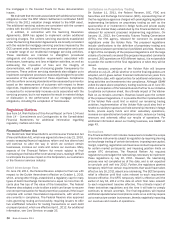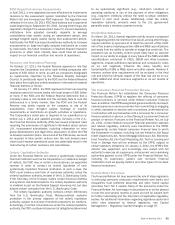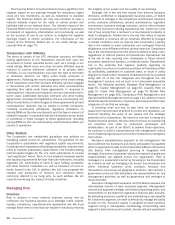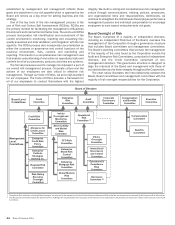Bank of America 2011 Annual Report Download - page 57
Download and view the complete annual report
Please find page 57 of the 2011 Bank of America annual report below. You can navigate through the pages in the report by either clicking on the pages listed below, or by using the keyword search tool below to find specific information within the annual report.Bank of America 2011 55
The GSEs’ repurchase requests, standards for rescission of
repurchase requests and resolution processes have become
increasingly inconsistent with their past conduct as well as our
interpretation of our contractual obligations. Notably, in recent
periods we have been experiencing elevated levels of new claims
from the GSEs, including claims on loans on which borrowers have
made a significant number of payments (e.g., at least 25
payments) or on loans which had defaulted more than 18 months
prior to the repurchase request, in each case, in numbers that
were not expected based on historical experience. Also, the criteria
and the processes by which the GSEs are ultimately willing to
resolve claims have changed in ways that are unfavorable to us.
These developments have resulted in an increase in claims
outstanding from the GSEs. We intend to repurchase loans to the
extent required under the contracts and standards that govern our
relationships with the GSEs. While we are seeking to resolve our
differences with the GSEs concerning each party’s interpretation
of the requirements of the governing contracts, whether we will be
able to achieve a resolution of these differences on acceptable
terms and timing thereof, is subject to significant uncertainty.
Beginning in February 2012, we are no longer delivering
purchase money and non-MHA refinance first-lien residential
mortgage products into FNMA MBS pools because of the expiration
and mutual non-renewal of certain contractual delivery
commitments and variances that permit efficient delivery of such
loans to FNMA. While we continue to have a valid agreement with
FNMA permitting the delivery of purchase money and non-MHA
refinance first-lien residential mortgage products without such
contractual variances, the delivery of such products without
contractual delivery commitments and variances would involve
time and expense to implement the necessary operational and
systems changes and otherwise present practical operational
issues. The non-renewal of these variances was influenced, in part,
by our ongoing differences with FNMA in other contexts, including
repurchase claims. We do not expect this change to have a material
impact on our CRES business, as we expect to rely on other sources
of liquidity to actively extend mortgage credit to our customers
including continuing to deliver such products into FHLMC MBS
pools. Additionally, we continue to deliver MHA refinancing
products into FNMA MBS pools and continue to engage in dialogue
to attempt to address these differences.
On June 30, 2011, FNMA issued an announcement requiring
servicers to report, effective October 1, 2011, all MI rescission
notices with respect to loans sold to FNMA. The announcement
also confirmed FNMA’s view of its position that a mortgage
insurance company’s issuance of a MI rescission notice
constitutes a breach of the lender’s representations and
warranties and permits FNMA to require the lender to repurchase
the mortgage loan or promptly remit a make-whole payment
covering FNMA’s loss even if the lender is contesting the MI
rescission notice. A related announcement included a ban on bulk
settlements with mortgage insurers that provide for loss sharing
in lieu of rescission. According to FNMA’s announcement, through
June 30, 2012, lenders have 90 days to appeal FNMA’s repurchase
request and 30 days (or such other time frame specified by FNMA)
to appeal after that date. According to FNMA’s announcement, in
order to be successful in its appeal, a lender must provide
documentation confirming reinstatement or continuation of
coverage. This announcement could result in more repurchase
requests from FNMA than the assumptions in our estimated
liability contemplate. We also expect that in many cases
(particularly in the context of individual or bulk rescissions being
contested through litigation), we will not be able to resolve MI
rescission notices with the mortgage insurance companies before
the expiration of the appeal period prescribed by the FNMA
announcement. We have informed FNMA that we do not believe
that the new policy is valid under our contracts with FNMA, and
that we do not intend to repurchase loans under the terms set
forth in the new policy. Our pipeline of outstanding repurchase
claims from the GSEs resulting solely on MI rescission notices
has increased during 2011 by $935 million to $1.2 billion at
December 31, 2011. If we are required to abide by the terms of
the new FNMA policy, our representations and warranties liability
will likely increase.
Experience with Investors Other than Government-
sponsored Enterprises
In prior years, legacy companies and certain subsidiaries have
sold pools of first-lien mortgage loans and home equity loans as
private-label securitizations or in the form of whole loans. As
detailed in Table 12, legacy companies and certain subsidiaries
sold loans originated from 2004 through 2008 with an original
principal balance of $963 billion to investors other than GSEs
(although the GSEs are investors in certain private-label
securitizations), of which approximately $506 billion in principal
has been paid and $239 billion has defaulted or are severely
delinquent at December 31, 2011.
As it relates to private-label securitizations, a contractual
liability to repurchase mortgage loans generally arises only if
counterparties prove there is a breach of the representations and
warranties that materially and adversely affects the interest of the
investor or all investors in a securitization trust or of the monoline
insurer or other financial guarantor (as applicable). We believe that
the longer a loan performs, the less likely it is that an alleged
representations and warranties breach had a material impact on
the loan’s performance or that a breach even exists. Because the
majority of the borrowers in this population would have made a
significant number of payments if they are not yet 180 days or
more past due, we believe that the principal balance at the greatest
risk for repurchase claims in this population of private-label
securitization investors is a combination of loans that have already
defaulted and those that are currently severely delinquent.
Additionally, the obligation to repurchase loans also requires that
counterparties have the contractual right to demand repurchase
of the loans (presentation thresholds). While we believe the
agreements for private-label securitizations generally contain less
rigorous representations and warranties and place higher burdens
on investors seeking repurchases than the explicit provisions of
the comparable agreements with the GSEs without regard to any
variations that may have arisen as a result of dealings with the
GSEs, the agreements generally include a representation that
underwriting practices were prudent and customary.
Any amounts paid related to repurchase claims from a monoline
insurer are paid to the securitization trust and are applied in
accordance with the terms of the governing securitization
documents, which may include use by the securitization trust to
repay any outstanding monoline advances or reduce future
advances from the monolines. To the extent that a monoline has
not advanced funds or does not anticipate that it will be required
to advance funds to the securitization trust, the likelihood of
receiving a repurchase claim from a monoline may be reduced as
the monoline would receive limited or no benefit from the payment
of repurchase claims. Moreover, some monolines are not currently



